Basketball Offense - Half-Court Press Breakers
Coach’s Clipboard, www.coachesclipboard.net
This page discusses a number of specific half-court press-breaks. But it doesn't have to be that complicated. For an effective half-court press-break that applies to most half-court presses, disregard this page and see the "40" press-break in "80-60-40 Press-Breakers".
Teams will sometimes throw a half-court press at you, especially if they think your ball-handlers are inexperienced and subject to committing turnovers. Steals at half-court can result in easy transition lay-ups for the defense.
The half-court press trap can look very intimidating to the point guard bringing the ball up the floor, when he/she sees a wall of two or three defenders waiting. So how do you counteract this defense?
First, try to push the ball up the floor as quickly as possible before the defense gets set. Using a secondary break after the opponent scores is oftentimes effective. O5 quickly gets the ball out of the net, and passes in quickly to your point guard. Meanwhile O2 sprints up the right sideline and O3 sprints up the left sideline. Oftentimes, O1 can hit either O2 or O3 with the long pass for the lay-up. See: Secondary Break.
But assuming the half court press is already set...
If it is a 3-1-1 half-court press...
This press is vulnerable to a pass up the sideline.Diagram A. Have a player move up along each sideline (O3 and O4), at about the top of the key extended. Send one receiver deep to keep their X5 defender from cheating up. Your point guard O1 should dribble to commit two defenders, and O2 slides to the sideline beyond the X2 defender. Just before the trap arrives, O1 passes to either O2, O4, or across to O3.
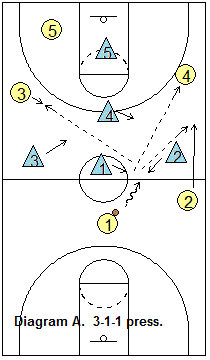
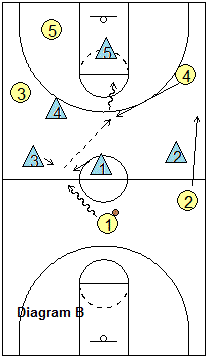
Diagram B. If the center defender shifts to cover the ball-side sideline (X3), then your opposite sideline player (O4) cuts to the middle spot vacated by the defender. O1 passes to the middle (O4) and O4 immediately drives to the hoop with the 2-on-1 situation with O5.
If it is a 2-2-1 half-court press...
Diagram C. Have your point guard attack the middle and draw the two top defenders. Just before the trap arrives, he/she passes to the open teammate. With a 2-2-1, have a tall receiver with good hands (your "tight end") set up in the middle between the two "second tier" defenders.O3 and O5 move down into the corners. Your point guard O1 can pass to the middle, or to O3 or O5 in the corners. In fact, most half court presses are vulnerable down low in the corners. Good accurate long passes over the defense into the corners will often beat this defense. If the back defender starts cheating toward the corner, then the middle is open.
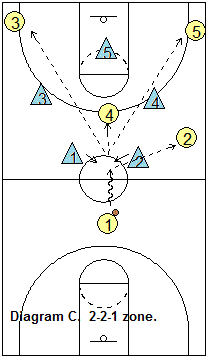
Another way to beat this press is have O2 set an outside screen on the X2 defender allowing O1 to dribble around the screen up the right sideline. The X4 defender may slide over to stop him, but O1 can make the quick pass into the corner to O5, and then O5 and O3 have a 2-on-1 situation with the X5 defender.
If is a 3-2 half-court zone press...
Diagram D. With three defenders across the half-court line, and two at the top of the key, again have your "tight end" in the middle (O4) and one of your wings along the ball-side sideline. Send one tall, good receiver deep, to the hoop. If the two back defenders cheat toward outside, you may find your deep receiver wide open for the "over the top" pass to the hoop.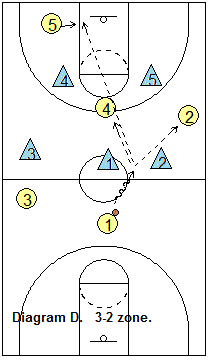
Sending a receiver deep will also help commit one of the back defenders to stay back, and allow your perimeter passing lanes to stay open. By forcing one defender to stay back, you have essentially converted their zone into a 3-1-1, which you know from above is easy to beat with the sideline pass. Your point guard O1 takes the ball to one side and tries to commit two defenders to him. Then either the "tight end" O4 or the sideline O2 will be open.
Against the 2-1-2 half court press...
Just put your players "where they ain't". Diagram A. In this instance, make sure O2, O3, O4 and O5 get up the floor as quickly as possible. They must beat the point guard up the floor and get into the positions indicated in diagram A. Instruct and drill your point guard not to dribble into the trap at the half court line. There are 10 seconds to get the ball across and this is enough time to look for the open teammate to pass to.O1 makes the pass just as the double team is coming - he/she draws the two defenders and then makes the pass to the side before the double team arrives. Drill this pass, because this is the one that gets intercepted the most - no lazy soft lob passes here. You may have to teach him to "look the defense off" and pass the opposite way to clear the passing lane.
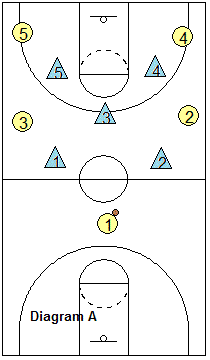
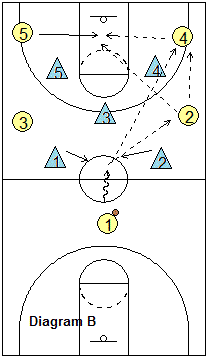
For example, if the pass goes to the right, either O2 or O4 should be open for the pass (diagram B). If the X4 defender cheats up and covers O2, then O4 should be open in the corner for the pass. Then O5 cuts to the paint for the pass from O4 and the lay-up. You can run the same thing on the opposite side using O3 and O5 as receivers.
If the X3 defender cheats toward the ball-side, you can bring O3 into the middle for the pass.
By using this setup, O1 is occupying two defenders, their X3 is really covering no-one, and their X4 and X5 have to try to cover two players at the same time.
Your point guard O1 has to learn to keep his head up, see the floor, be patient, stay calm and find the open teammate with a good quick pass, just before the trap gets to him. Teach him/her to avoid dribbling between two or three defenders, but stay patient and make the good pass. You drill this in practice.
Teach your team that once the pass gets into your "tight end" or up the sidelines, you should have cutters slashing to the hoop for a quick pass and lay-up. Often your "tight end" can pivot, face the hoop and find the deep man wide open for the lay-up.
Once you get through their press line at half court, you've got them beat and should be looking for a lay-up, a quick score. After you burn 'em a few times, they'll drop the press.
If it is a 1-3-1 Half-Court Press...
Use a 2-1-2 offensive set. Have your two guards flank the point defender. Have two offensive players deep up the side-lines flanking the one deep defender and beyond the three-across defenders.O1 dribbles a little toward one side to get the point defender and the zone to commit to that side. O1 can pass over-the-top of the zone up the sideline, or can make the reverse pass to the opposite guard O2 who is still behind (neither have crossed the 10-second line yet).
O2 then looks to pass up his sideline, or to dribble penetrate if the zone is shifted out of position. They may try to trap here so he/she needs to learn to pass up the side quickly before the trap arrives.
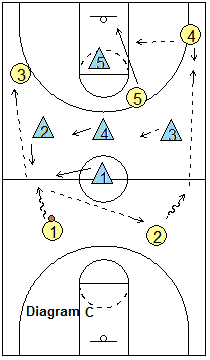
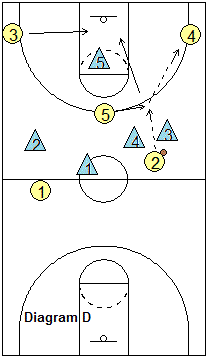
If the middle back defender (X5) slides over to the sideline to prevent that pass, then have your middle player O5 drop to the basket in the middle and hit him with the pass over the top. A couple lay-ups later and they'll drop the press. Another option: if X3 and X4 attempt to trap O2, then O5 slides to that sideline for the pass from O2 (diagram D).
If it is a 1-1-2-1 Half Court Trap...
When attacking a this half court trap, make sure two of your players get down the floor into your forecourt before the ball and the point guard O1 arrives, and they should get deep up the sidelines, beyond the deep defender. With this alignment, the defense is trying to get your point guard to commit first, either to the right or left. One option would be for the point guard to delay before crossing the half court line and make the long over-the-top pass to either corner.Another option would be to have the two remaining players (O2 and O3) positioned even with and on both sides of O1 as he/she crosses the line. The point can make the quick pass to either side, and then the pass goes quickly from that side straight up the sideline to the player deep in that corner. Once the ball gets into the corner areas, have your wings cut thru looking for the pass back and lay-up.
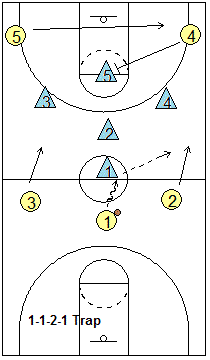
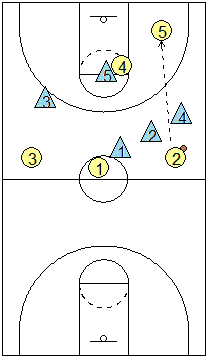
Now, one other thing. If the initial pass from the point goes to one side, then have the opposite side player (not the opposite corner player) cut to the middle looking for a pass in case the middle defender cheats to the ball-side.
There might even be an occasion when the player with the ball on the side may have to make the deep, skip pass to the opposite corner, which should always be open - just make sure you've got someone who can accurately make that pass, and with some zip on the pass.
You can also screen the deep zone defender - pin the defender so he/she can't move to either the sideline or down low. Then cut your opposite deep corner player to the ball-side for the pass and layup. This screen and cut must be done quickly, before O2 gets trapped. The cutter should be in position almost as O2 gets the ball.
If it is a 1-2-1-1 Half Court Trap...
See the diagrams below. When attacking this half court trap, make sure three of your players get down the floor into your forecourt before the ball the point guard arrives.O3 and O4 get deep up the sidelines. O5 gets to the middle of the zone on the same side as the guard who does not have the ball (the intended receiver of the first pass O2). He/she can screen and get ball-side position on the middle defender (see diagram).
You can also screen and pin the deep zone defender so he/she can't move to the sideline or down low. Then cut your opposite deep corner player to the ball-side for the pass and layup. This screen and cut must be done quickly, before O2 gets trapped. The cutter should be in position almost as O2 gets the ball, so the pass can be made before the trap arrives.
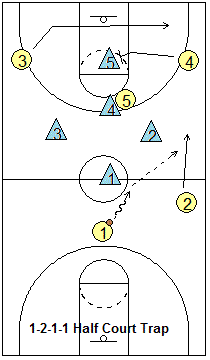
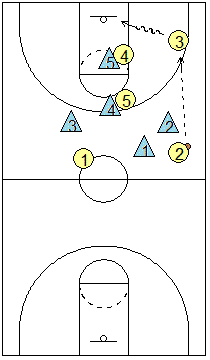
One last tip...
If your point guard O1 is small and having difficulty getting his/her passes intercepted by the taller defenders, try this. Have one of your taller players (who is a good passer), stay back with your point guard in the back-court, and along one of the sidelines.Just before the point guard reaches the half court line, he/she passes sideways to his taller teammate who makes the pass up the floor. Encourage this post player to pass and not attempt to dribble (especially is he/she is not accustomed to dribbling in the open court).
Related page: